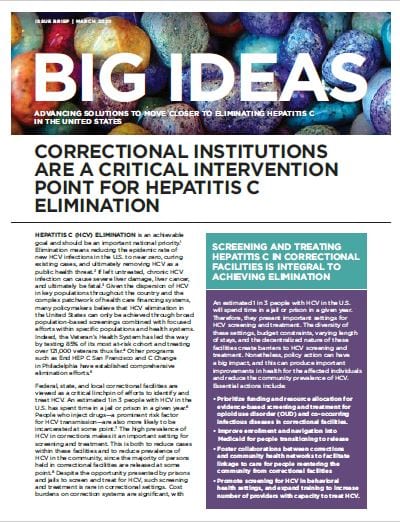 The O’Neill Institute’s Hepatitis Policy Project recently released its latest issue brief, Correctional Institutions Are A Critical Intervention Point For Hepatitis C Elimination, written by Senior Associate Sonia Canzater, on the integral role expanding hepatitis C virus (HCV) screening and treatment in the nation’s jails and prisons could play in the effort to eliminate HCV as a public health threat in the U.S.
The O’Neill Institute’s Hepatitis Policy Project recently released its latest issue brief, Correctional Institutions Are A Critical Intervention Point For Hepatitis C Elimination, written by Senior Associate Sonia Canzater, on the integral role expanding hepatitis C virus (HCV) screening and treatment in the nation’s jails and prisons could play in the effort to eliminate HCV as a public health threat in the U.S.
The high rates of HCV infections in the U.S. are tied to injection drug use largely associated with the current opioid crisis. Behaviors linked to substance use often lead people with substance use disorder to encounter the criminal justice system, and 1 in 3 people in the U.S. with HCV pass through the correctional system in a given year. Despite some states reporting rates of HCV in their prison population as high as 39%, only 35% of state prisons provide routine HCV screening, and only 3% of people in prisons have access to HCV treatment. For many, local jails are the initial entry point into the correctional system. Detainment in jails, however, often lasts only a few days or weeks. The cost of treatment drugs and uncertainty of how long a person may remain in custody pose barriers to the willingness of jail administrators to screen and commence treatment for HCV.
The 1976 U.S. Supreme Court case of Estelle v. Gamble ruled that denying “the community standard of care” for the health needs of incarcerated persons was a violation of the Constitutional protections against cruel and unusual punishment guaranteed under the 8th Amendment. Direct acting antiviral oral drug therapies that provide a cure for HCV following 8-12 weeks of treatment have been the standard of care for HCV for over 7 years, yet these treatments are largely inaccessible to incarcerated persons with HCV. Recent litigation and case settlements brought against correctional facilities have required an increasing number of jurisdictions to provide HCV treatment in their correctional facilities and change policies to provide universal opt-out screening for all detained, and facilitate HCV treatment both while incarcerated and to continue care once people are released. Timely screening and treatment of HCV in correctional facilities could greatly decrease the rate of HCV cases and the risk of continued transmission throughout the greater population, as 95% of people in state prisons are eventually released back into their communities.
Several jurisdictions, such as San Francisco, Philadelphia, and Louisiana, have made great strides in screening and treating their corrections populations and ensuring access to treatment and related services to those returning to the community. Still, much more needs to be done to prioritize these populations and allocate the needed fiscal and workforce resources to provide widespread screening and treatment throughout the corrections population and make significant strides towards eliminating HCV in the U.S.



